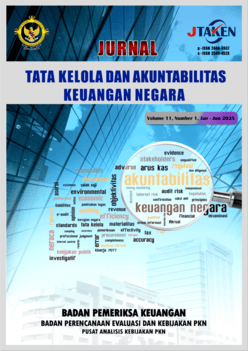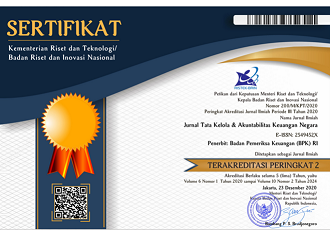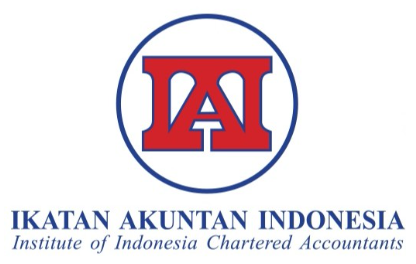Bridging policy and practice: The implementation of inventory accounting standards in Indonesian local governments
DOI:
https://doi.org/10.28986/jtaken.v11i1.2068Keywords:
Inventory Accounting, Accounting Standards, Public Sector, Inventory ReconciliationAbstract
Inventory accounting plays a critical role in public sector financial management, supporting transparency, asset control, and budget accountability. This study examines the challenges associated with implementing inventory accounting standards in Indonesian local governments, with a particular focus on inventory recording, classification, and governance. Using an interpretive qualitative approach, the research draws on document analysis of national and international accounting standards and focus group discussions with government accounting practitioners. The findings reveal persistent difficulties in integrating financial and inventory systems, notably due to discrepancies in classification codes, incomplete asset handover documentation, and fragmented regulatory frameworks. The transition to digital inventory management remains hindered by limited technical capacity, system fragmentation, and inconsistent application of valuation methods, especially the use of first-in, first-out (FIFO) and first-expired, first-out (FEFO) approaches in the health and procurement sectors. These issues contribute to inefficiencies in financial reporting and elevate audit risks. The study highlights the need for regulatory harmonization, improved interdepartmental coordination, and stronger governance mechanisms to enhance compliance and transparency. The adoption of integrated digital tracking systems and standardized reporting procedures is also recommended to reduce inconsistencies and improve audit readiness. This research contributes to the literature by offering practical insights into regulatory misalignment and proposing strategies to improve inventory management in local government.
References
AASB. (2015). Accounting standard of Australian accounting standards board - AASB 102 accounting for inventories. https://www.aasb.gov.au/admin/file/content105/c9/aasb102_07-15.pdf
Ahmed, E., Alabdullah, T., Ardhani, L., & Putri, E. (2021). The inventory control system’s weaknesses based on the accounting postgraduate students’ perspectives. Journal of Accounting and Business Education, 5(2), 1-8. http://dx.doi.org/10.26675/jabe.v5i2.19312
Brusca, I., Montesinos, V., & Chow, D. S. L. (2013). Legitimating international public sector accounting standards (IPSAS): The case of Spain. Public Money & Management, 33(6), 437–444. https://doi.org/10.1080/09540962.2013.836006
Christiaens, J., Reyniers, B., & Rollé, C. (2010). Impact of IPSAS on reforming governmental financial information systems: A comparative study. International Review of Administrative Sciences, 76(3), 537–554. https://doi.org/10.1177/0020852310372449
Christiaens, J., Vanhee, C., Manes-Rossi, F., Aversano, N., & van Cauwenberge, P. (2015). The effect of IPSAS on reforming governmental financial reporting: An international comparison. International Review of Administrative Sciences, 81(1), 158–177. https://doi.org/10.1177/0020852314546580
Cohen, S., Manes Rossi, F., Caperchione, E., & Brusca, I. (2019). Local government administration systems and local government accounting information needs: Is there a mismatch? Public Administration, 97(3), 674–691. https://doi.org/10.1177/0020852317748732
Diamond, J., & Khemani, P. (2005). Introducing financial management information systems in developing countries (IMF Working Paper No. 05/196). https://doi.org/10.5089/9781451862157.001
FASB. (2015). Accounting standard update no 2015-11 simplifying the measurement of inventory. https://asc.fasb.org/1943274/1855115/GUID-718C3B83-4747-407F-820D-687C9BC75F96
Galdi, F. C., & Johnson, E. S. (2021). Accounting for inventory costs and real earnings management behavior. Advances in Accounting, 53, 100530. https://doi.org/10.1016/j.adiac.2021.100530
Government Accounting Standards Committee. (2020). Government Accounting Standards. https://www.ksap.org/sap/wp-content/uploads/2021/02/Handbook-SAP-2020-R.pdf
IFRS. (2024). IAS 2 inventories. https://www.ifrs.org/issued-standards/list-of-standards/ias-2-inventories/
IPSAS. (2023). Handbook of international public sector accounting pronouncements. https://www.ifac.org/publications-resources/2023-handbook-international-public-sector-accounting-pronouncements
IPSAS. (2024a). IPSAS 12 inventories. https://www.ifac.org/_flysystem/azure-private/publications/files/ipsas-12-inventories-4.pdf
IPSAS. (2024b). IPSAS 5 borrowing cost. https://www.ifac.org/_flysystem/azure-private/publications/files/ipsas-5-borrowing-costs-2.pdf
Kieso, D. E., Weygandt, J. J., & Warfield, T. D. (2022). Intermediate accounting: IFRS edition. Wiley. https://books.google.co.id/books?id=1JBEDwAAQBAJ
Komite Standar Akuntansi Pemerintahan. (2021). Pernyataan Standar Akuntansi Pemerintahan (PSAP) nomor 05 tentang akuntansi persediaan. https://www.ksap.org/standar/PSAP05.pdf
Lucchese, M., & Di Carlo, F. (2020). Inventories accounting under US-GAAP and IFRS standards: The differences that hinder the full convergence. International Journal of Business and Management, 15(7), 180-195. https://doi.org/10.5539/ijbm.v15n7p180
Maulida, S., & Kurniawan, R. (2023). Impact of liquidity and inventory variability on profitability in FIFO and average inventory methods. Summa Journal of Accounting Research, 4(1), 86-101. https://doi.org/10.61978/summa.v1i1.86
McLeod, R. H., & Harun, H. (2014). Public sector accounting reform at the local government level in Indonesia. Financial Accountability and Management, 30(2), 238-258. https://doi.org/10.1111/faam.12035
Miles, M. B., Huberman, A. M., & Saldan, J. (2019). Qualitative data analysis: A methods sourcebook (4th ed.). Sage Publications, Inc.
Modell, S., Humphrey, C., Elharidy, A. M., Nicholson, B., & Scapens, R. W. (2008). Using grounded theory in interpretive management accounting research. Qualitative Research in Accounting & Management, 5(2), 139–155. https://doi.org/10.1108/11766090810888935
Muna, A., Firasati, A., & Lestari, W. F. (2023). The Effect of inventory variability on the selection of inventory accounting methods in industrial and consumer goods sectors. Research Trends in Accounting and Finance, 2(1), 11-25. https://doi.org/10.56442/rttm.v1i22.11
Mustofa, A., Ekasari, K., & Kusmintarti, A. (2021). Implementation of inventory accounting information systems at Tirta Pharmacy. International Journal of Economics, Business and Accounting Research, 5(2), 2478-2491. https://doi.org/10.29040/ijebar.v5i2.2478
Paré, G., & Elam, J. J. (1997). Using case study research to build theories of IT implementation. In A. S. Lee, J. Liebenau, & J. I. DeGross (Eds.), Information systems and qualitative research: Proceedings of the IFIP TC8 WG 8.2 International Conference on Information Systems and Qualitative Research, 31st May--3rd June 1997, Philadelphia, Pennsylvania, USA (pp. 542–568). Springer US. https://doi.org/10.1007/978-0-387-35309-8_27
Pulakanam, V., & Suraweera, T. (2010). Implementing accounting software in small businesses in New Zealand: An exploratory investigation. Accountancy Business and the Public Interest, 9(64), 98-124. http://rda.sliit.lk/handle/123456789/1310
Taylor, L. C. (2018). Reassessing and refining theory in qualitative accounting research: An illustrative account of theorizing. Qualitative Research in Accounting & Management, 15(4), 510–534. https://doi.org/10.1108/QRAM-09-2017-0090
Urdari, C., & Tudor, A. T. (2014). Qualitative studies in accounting: The Abductive research strategy. SEA: Practical Application of Science, 2(3), 85–92. https://seaopenresearch.eu/Journals/articles/SPAS_5_12.pdf
Downloads
Submitted
Accepted
Published
How to Cite
Issue
Section
License
Copyright (c) 2025 Jurnal Tata Kelola dan Akuntabilitas Keuangan Negara

This work is licensed under a Creative Commons Attribution-ShareAlike 4.0 International License.

Jurnal Tata Kelola dan Akuntabilitas Keuangan Negara is licensed under
a Creative Commons Attribution-ShareAlike 4.0 International License





















